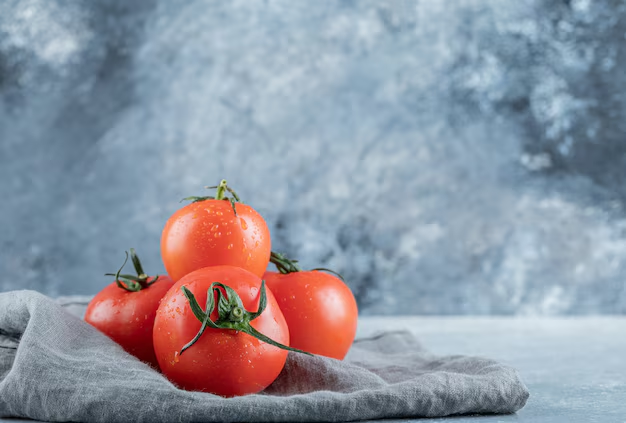How Long Do Tomatoes Stay Fresh in the Refrigerator?
Tomatoes are a staple in many kitchens worldwide due to their versatility and flavor. From an Italian pasta sauce to a fresh garden salad, they're used in an array of delicious recipes. But how do you ensure that your tomatoes remain fresh and flavorful once they find their way into your home? This comprehensive guide will help you understand the best ways to store tomatoes, particularly focusing on how long they remain fresh when stored in the refrigerator. We’ll explore essential tips for maximizing shelf life and discuss the factors affecting their freshness.
🍅 Understanding Tomato Storage
Before delving into refrigerator storage, it's crucial to understand why and how storage affects tomatoes. Tomatoes are unique in that they can continue to ripen even after being picked. They contain a natural hormone called ethylene, which induces ripening. Let's explore how you can store them to get the best out of this natural process.
The Ripening Process
- Countertop Storage: For tomatoes that are not fully ripe, countertop storage is ideal. It allows them to finish ripening, making them juicier and more flavorful.
- Refrigerator Storage: Fully ripe tomatoes can be stored in the fridge to extend their usability. However, being mindful of how long they're kept there is critical.
🕒 Shelf Life of Refrigerated Tomatoes
Tomatoes stored in the refrigerator typically have a shelf life of about 5 to 7 days. However, this can vary depending on the tomato's initial ripeness, temperature settings, and storage conditions.
Factors Affecting Shelf Life
- Ripeness at Time of Storage: The ripeness when you place tomatoes in the fridge impacts how long they'll stay fresh. Overripe tomatoes are more susceptible to quick spoilage.
- Temperature and Humidity: A consistent, slightly cooler temperature helps extend shelf life. Too much moisture can accelerate spoilage, so ensure your fridge’s humidity levels are moderate.
- Storage Method: How you store them in your fridge also plays a role. Whole, uncut tomatoes last longer than chopped or sliced tomatoes.
🧊 Proper Refrigeration Techniques
To extend the shelf life of tomatoes in the refrigerator, proper storage techniques are essential. Here’s how you can optimize the freshness of your refrigerated tomatoes:
Storing Whole Tomatoes
- Container Choice: Use a crisper drawer if your fridge has one. This compartment is designed to maintain proper humidity levels for produce.
- Separation from Other Produce: Because tomatoes emit ethylene gas, store them away from other fruits and vegetables sensitive to this hormone, like leafy greens, to prevent premature ripening.
Storing Cut Tomatoes
- Use Airtight Containers: If you've cut your tomatoes, store them in airtight containers to prevent them from drying out and absorbing other fridge odors.
- Use within 1-2 Days: Sliced or chopped tomatoes should ideally be used within a day or two for optimal freshness.
🍽️ How to Tell if Refrigerated Tomatoes Have Spoiled
While extending shelf life is useful, knowing when tomatoes have gone past their prime is equally important. Here are a few indicators:
Signs of Spoilage
- Wrinkled Skin: While some wrinkling is natural, excessive wrinkling can indicate dehydration and reduced quality.
- Off-Smell or Mold: A sour smell or visible mold are clear signs of spoilage; such tomatoes should be discarded immediately.
- Mushy Texture: Tomatoes that have become mushy are losing their structure and flavor, indicating they are past their prime.
🍅 Enhancing Tomato Shelf Life Without Refrigeration
If you prefer not to refrigerate tomatoes but still want to keep them fresh longer, consider these tips:
- Use Vine Ripened Tomatoes: These tend to have better lasting power and remain flavorful longer at room temperature.
- Store Upside Down: Placing tomatoes stem-side down can help prevent moisture loss.
- Dehydration: Turn excess tomatoes into sun-dried tomatoes, which last longer and add a concentrated flavor boost to dishes.
📋 Practical Tips for Tomato Storage
Here's a summary of practical tips to help you store your tomatoes effectively:
- 🥶 Keep in the Fridge: Only once fully ripe.
- 🧊 Optimal Temperature: Aim for a consistent cooler fridge setting.
- 🍂 Separate from Ethylene-Sensitive Produce: Maintain freshness by preventing rapid ripening.
- 📦 Use Airtight Containers: Especially for cut tomatoes.
- 🔄 Rotate Stock: Use older tomatoes first to minimize waste.
- 🎨 Visual Check: Regularly inspect tomatoes for signs of spoilage.
🌟 Unlocking the Potential of Fresh Tomatoes
Understanding the lifespan of your tomatoes when storing them in the refrigerator helps in planning meals and reducing food waste. Fresh tomatoes retained at their peak condition are more flavorful and nutritious, elevating your culinary creations.
For those who cultivate their own tomatoes, these guidelines are equally beneficial, offering methods to ensure that even when the harvest is abundant, no tomato goes to waste. 🌻
In conclusion, while tomatoes stored in the fridge typically last 5 to 7 days, being attuned to the subtleties of ripeness, temperature, and storage can significantly enhance their longevity. By applying these insights, you'll keep your tomatoes fresh and delicious, ready to be transformed into any number of wonderful dishes. Your culinary endeavors benefit from this knowledge—and so does your taste palate. Enjoy the vibrant bounty of tomatoes in whichever way you choose to prepare them!
